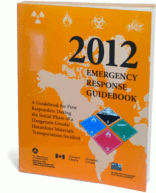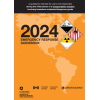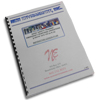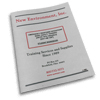4-Hour Basic Safety Training
our E-Newsletter

This course is designed to acquaint students with various methods of observation needed to determine the presence of Hazardous Materials in the work place.
Also, it is a prerequisite to our 40-Hour Hazardous Waste Worker Program for those students who do not meet the prerequisite requirements.
Jump To Section
Regulation |
Open Enrollment Seminars |
Other Course Options |
Individual Products
Open Enrollment Seminars
This class is not scheduled for any upcoming seminars. It is available for On-Site
Training; call or E-mail us to schedule a seminar.
Optionally, you can purchase the On-Site Training Seminar Kit below.
Course Regulation
This course is designed to acquaint students with various methods of observation needed to determine the presence of Hazardous Materials in the work place.
29 CFR 1910.120:- (e)(1)(i): All employees working on site (such as but not limited to equipment operators, general laborers and others) exposed to hazardous substances, health hazards, or safety hazards and their supervisors and management responsible for the site shall receive training meeting the requirements of this paragraph before they are permitted to engage in hazardous waste operationss that could expose them to hazardous substances, safety, or health hazards, and they shall receive review training as specified in this paragraph.
- (e)(3)(i): General site workers (such as equipment operators, general laborers and supervisory personnel) engaged in hazardous substance removal or other activities which expose or potentially expose workers to hazardous substances and health hazards shall receive a minimum of 40 hours of instruction off the site, and a minimum of three days actual field experience under the direct supervision of a trained experienced supervisor.
- (e)(3)(ii): Workers on site only occasionally for a specific limited task (such as, but not limited to, ground water monitoring, land surveying, or geophysical surveying) and who are unlikely to be exposed over permissible exposure limits and published exposure limits shall receive a minimum of 24 hours of instruction off the site, and the minimum of one day actual field experience under the direct supervision of a trained, experienced supervisor.
- (e)(3)(iii): Workers regularly on site who work in areas which have been monitored and fully characterized indicating that exposures are under permissible exposure limits and published exposure limits where respirators are not necessary, and the characterization indicates that there are no health hazards or the possibility of an emergency developing, shall receive a minimum of 24 hours of instruction off the site, and the minimum of one day actual field experience under the direct supervision of a trained, experienced supervisor.
- (e)(3)(iv): Workers with 24 hours of training who are covered by paragraphs (e)(3)(ii) and(e)(3)(iii) of this section, and who become general site workers or who are required to wear respirators, shall have the additional 16 hours and two days of training necessary to total the training specified in paragraph (e)(3)(i).
- It is also a prerequisite to our 40-Hour Hazardous Waste Worker.
The Following Topics are Covered in this Course


- Regulatory Overview
- Emergency Response Guidebook
- Personal Protective Equipment
- Basic Site Control Procedures
- Decontamination Procedures
- Hazardous Material Terminology
- Course Review And Final Test
Other Course Options
On-Site Training
New Environment, Inc. offers On-Site Training for this course, call or E-mail us to schedule this course.
Individual Products
Instructor Materials
Student Materials
DOT Emergency Response Guidebook

This Guidebook is primarily a guide to aid first responders in quickly identifying the specific or generic hazards of the material(s) involved in the incident, and protecting themselves and the general public during the initial response phase of the incident.
The Emergency Response Guidebook is updated every three to four years to accommodate new products and technology.
Use this DOT-issued guidebook to help you satisfy DOT's requirement that Hazmat shipments be accompanied by emergency response information (49 CFR Section 172.600).
View the 2024 Emergency Response Guidebook Summary of Changes from 2020.
Published by the U.S. Department of Transportation. 4"x5.25" Pocket Version


 Fully editable PowerPoint presentation for 4-Hour Basic Safety Training
Fully editable PowerPoint presentation for 4-Hour Basic Safety Training
